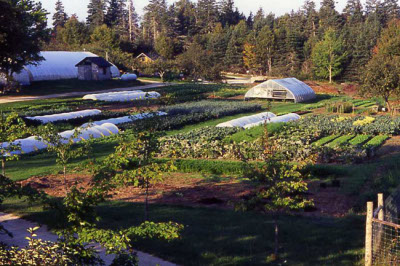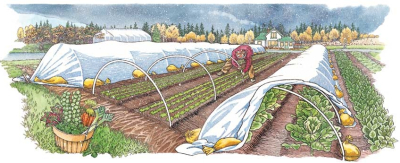
Winter garden protection: Quick hoops
 Eliot
Coleman's method of growing winter crops under row covers inside
unheated greenhouses clearly works like a charm for the market
gardener, but can those of us just growing for ourselves follow
suit? First of all, Coleman writes that true southerners (those
in zones 8 and 9) can probably get away with growing winter crops under
just row covers, and my father's experience in South Carolina bears
that out. And Coleman also presents a simpler alternative that
may provide all the protection we would need here in zone 6 --- quick
hoops.
Eliot
Coleman's method of growing winter crops under row covers inside
unheated greenhouses clearly works like a charm for the market
gardener, but can those of us just growing for ourselves follow
suit? First of all, Coleman writes that true southerners (those
in zones 8 and 9) can probably get away with growing winter crops under
just row covers, and my father's experience in South Carolina bears
that out. And Coleman also presents a simpler alternative that
may provide all the protection we would need here in zone 6 --- quick
hoops.
Coleman makes his quick
hoops by bending ten foot lengths of 1/2" electrical conduit into half
circles, then sinking ten inches of each end into the ground so that
the hoop covers an area about six feet wide. After placing a hoop
every five feet along the rows, he covers them with ten foot wide
sections of row cover which are weighed down on the edges with
sandbags. Once very cold weather threatens, he adds a sheet of
plastic on top (primarily to shed snow?)
 In effect, Coleman's quick
hoops are a combination of a floating row cover and a hoop house.
He notes that a quick hoop costs only 5% as much as the same square
footage of greenhouse and protects low-growing overwintering crops like
onions, spinach, and lettuce so that they can be harvested very early
in the spring on his farm in Maine.
In effect, Coleman's quick
hoops are a combination of a floating row cover and a hoop house.
He notes that a quick hoop costs only 5% as much as the same square
footage of greenhouse and protects low-growing overwintering crops like
onions, spinach, and lettuce so that they can be harvested very early
in the spring on his farm in Maine.
I'm tempted by his quick
hoop concept much more than by his larger scale greenhouses, but I have
a few reservations. First of all, I'm not thrilled by the
recurring cost of buying row cover fabric --- under heavy use, it tends
to last only a year or two. On the other hand, I could cover most
of the mule garden with row cover fabric for only $40, which would
probably be about equivalent to the cost of cooling that amount of
summer produce over the winter in the freezer. The sticking point
would be whether our cats and dog love jumping on the quick hoops and
tearing them to pieces as much as they love ruining my cold frames ---
if so, buying row cover fabric multiple times a year just wouldn't be
worth it.
The other question is
--- are quick hoops enough to protect a winter harvest here in chilly
zone 6? Coleman didn't seem to think so, but he also advocated
using the lowest tech solution first to try it out before moving up to
more expensive solutions, so I think he would approve of us trying
quick hoops on our farm.
| This post is part of our Winter Harvest Handbook lunchtime series.
Read all of the entries: |
Want more in-depth information? Browse through our books.
Or explore more posts by date or by subject.
About us: Anna Hess and Mark Hamilton spent over a decade living self-sufficiently in the mountains of Virginia before moving north to start over from scratch in the foothills of Ohio. They've experimented with permaculture, no-till gardening, trailersteading, home-based microbusinesses and much more, writing about their adventures in both blogs and books.
Want to be notified when new comments are posted on this page? Click on the RSS button after you add a comment to subscribe to the comment feed, or simply check the box beside "email replies to me" while writing your comment.
